To some, innovation in farming in India has already arrived in form of Artificial Intelligence (AI). To others, AI applications in the agricultural industry in India appear superfluous and primitive, and likely carry limited potential at best.
In India, modern technology in agriculture, often written as Agtech or Agritech, represents hope. That’s because traditional farming practices often fall sadly short when facing challenges like changing climate conditions and global warming.
Technology giants as well as startups are trying to combat several issues by building farming, irrigation and weather technology solutions. For example, Microsoft precision agriculture attempts to “democratizing AI for farmers around the world”. Startups are finding ways so that farmers can receive various inputs and suggestions over feature phones – even a smartphone isn’t required.
The push by the Government of India
In September 2019, the Department of Agriculture GoI emphasized that technology is a major thrust area for the government. Sanjay Aggarwal, Secretary of Agriculture, said, “AI and big data are going to be a game-changer in the agriculture sector and the government is aiming to collate about 80% of such data by 2020.”
To begin with, the government runs a number of beneficiary schemes for farmers. Data would help assess the efficacy of these schemes and improve better targeting.
He said the government is looking to collect data regarding soil health, crop insurance, and Kisan credit card. Considering that 85 million farmers have registered for the PM-KISAN scheme, the government should be in a strong position to collect, collate and leverage data.
All this makes it important to understand where India stands in AI. This article covers details of applications of artificial intelligence in agriculture and the future of AI in agriculture in India.
Context for agriculture automation in India
Consider the following:
- The agriculture and the allied sector contributes less than 16% to its US$ 3 trillion economy today. (Source).
- Agriculture directly employs 41.1% of India’s working age population (Source).
- Nearly 50% of India’s land is tilled (Source: Agriculture Census, 2015-16)
So here’s the paradox: To create one-sixth of the total Indian economy, it takes nearly half of India’s land, and that too while employing 2 of every 5 Indians.
This underlines the fact that Indian agriculture is nowhere close to being productive. While the government’s initiatives like the Green Revolution have certainly made the nation self-sufficient in food grains, there is a long, long way to go for agriculture to catch up with other industries.
No prizes for guessing that the answer lies in automation in agriculture, deploying advanced agriculture technology like robotics, AI and Machine Learning (ML).
How AI could benefit agriculture
Agritech has found a worthy partner in AI. In India, the role of artificial intelligence in agriculture can be much bigger than in any other field. That’s because it can reduce costs, improve quality, increase productivity and optimally use resources.
Here are a few use cases that showcase the use of AI in agriculture in India and how self-evolving systems can take agriculture to the next level in India:
1. Soil Analysis and Monitoring

Objective: Monitor soil health and identify specific needs of the soil in general and also in particular reference to the crop targeted
Who is doing it: CropIn, Bengaluru.
Details: The company reports the experiments it conducted in farms that had a collective size of 5,200 acres. The company helped in remote sensing and weather advisory. Based on data collected and analyzed, it offered tips on scheduling and monitoring at various stage of farming. It also offered farmers training on how to maintain and monitor crop health and offered alerts on impending pests or diseases.
2. Image Analysis
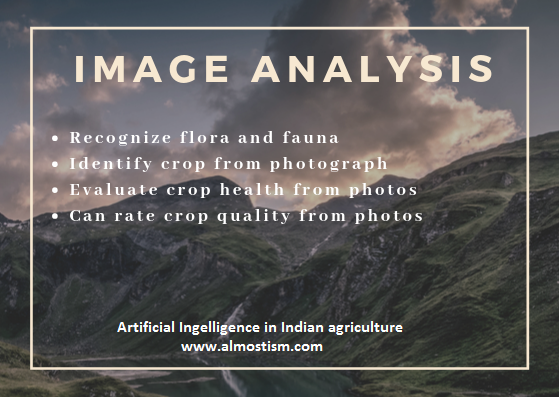
Objective: Recognize faces, flora and fauna and other objects and tag them in images
Who is doing it: Intello Labs, Bengaluru
Details: Intello claims it leverages deep learning algorithms for a variety of activities. A click of a photograph can identify the crop’s health. That will tell the farmer what, if anything, needs to be done. The technology can also identify the quality of the harvested product using the photograph. As one of the leading agricultural robotics companies in India, Intello says it can also offer alerts on pest infestation.
3. Predictive analysis

Objective: Suggest the right times to sow the seeds without expensive investment on the part of farmers
Who is doing it: Microsoft India
Details: The AI-based app for sowing that Microsoft tested relied on the climate data collected over 30 years (1986-2015). An important metric MAI (Moisture Adequacy Index) that estimates the amount of rainfall and moisture required for a good crop was calculated. Then it estimated the best times to sow crops. At the right time, farmers were sent automated voice messages and text messages. Farmers just needed to have a basic mobile phone (a feature phone). Farmers did not require have any scanners or any other expensive instruments – that’s the power of new-age agtech.
4. Supply chain management
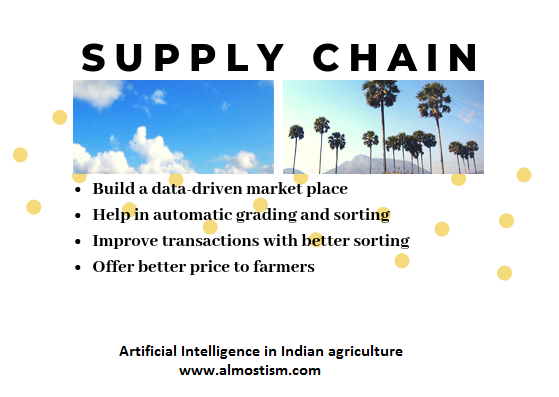
Objective: Deliver a data-driven online marketplace for agriculture that offers better prices to farmers as well as buyers
Who is doing it: Gobasco, Lucknow
Details: The advantage that Gobasco brings, according to the company, is the AI-optimized automated pipelines for the agriculture produce supply chain. The company further claims they have designed the supply chain keeping mind the India. Apart from the supply chain, the technology tool is supposed to help farmers in automated grading and sorting, leading to smoother transactions for domestically and internationally.
5. Crop cycle expertise
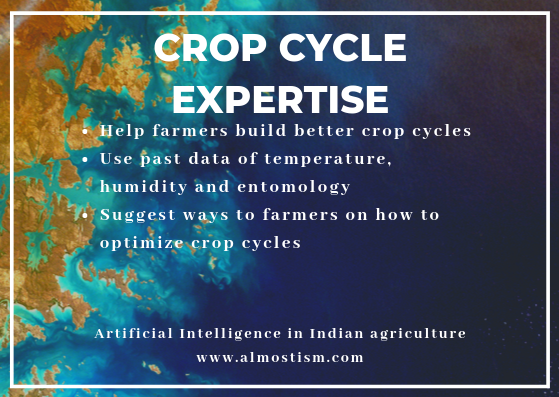
Objective: Help farmers build better crop cycles
Who is doing it: Gramophone, Indore
Details: A problem that AI-powered chatbots in agriculture need to solve is figuring out the correct crop cycle. Gramophone claims to have invested two years in ground work. Their technology platform leverages ML as well as AI for predictions that range from pest infestation to pricing. Based on the data of temperature, humidity and entomology, the company seeks to provide “personalized farm management solutions” that would guide farmers for the optimal cropping cycle.
6. Farm produce aggregation
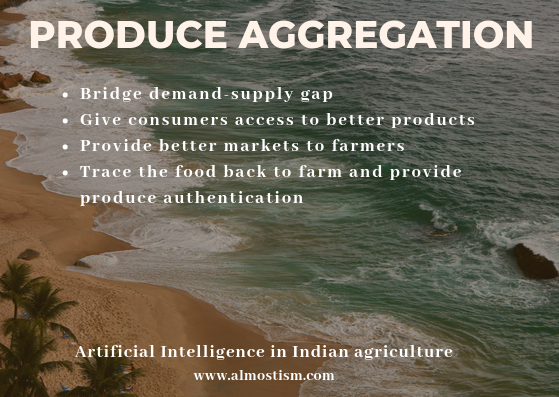
Objective: Bridge supply demand gap of agricultural produce
Who is doing it: Jivabhumi, Bengaluru
Details: The scope of AI in agriculture in India can be understood from the way the technology can provide an efficient platform for buyers and sellers of agricultural produce. According to Jivabhumi, their tool will bridge the gap between farmers looking to find markets and consumers looking for affordable agricultural produce. The agtech solution, using blockchain, is capable of tracing the food back to the farm, something that can ensure buyers of the safety of the food they buy.
7. Farmer Advisory
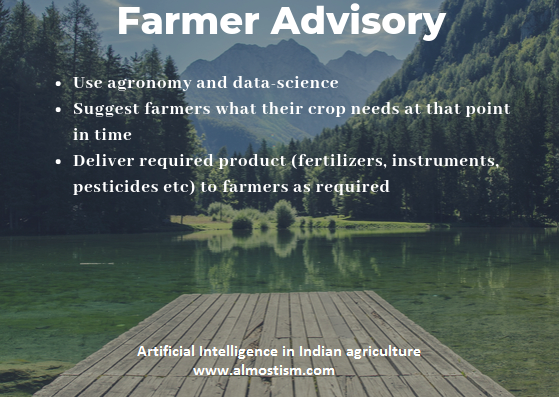
Objective: Provide comprehensive advice and tips along with required service
Who is doing it: Agrostar, Pune
Details: Agrostar claims to be using a combination of knowledge of agronomy, advanced technology and lots of data to offer advisory services to Indian farmer. Currently operating in the three states of Gujarat, Maharashtra and Rajasthan, Agrostar offers service that begins by helping the farmer identify what their crop needs at the moment and ends at doorstep delivery of whatever is needed. This is perhaps how digital farming in India can lead to a more efficient agriculture industry.
8. The IBM project
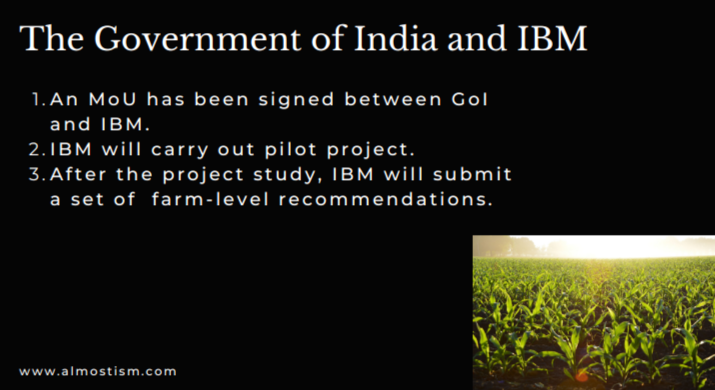
The Government of India has signed an MoU with IBM.
What: Under this MoU, IBM will conduct pilot projects in states like Madhya Pradesh and Gujarat. This project will use IBM’s AI capabilities, in addition to satellite imagery.
How: IBM will put its AI tool Watson to work. Based on the data analysis, Watson will come up with weather forecast and soil moisture information to farmers. This will enable farmers to make technology- and data-driven decisions.
Further benefits: Farmers will receive accurate insights on preparing the soil, choosing the right crop, ploughing, timing and dosage suggestions for pesticides, harvesting and more.
Where India stands vis-a-vis China
China, a country that faces nearly the same challenges as India does, is growing at a swift pace when it comes to AI. It is deploying AI to build the now well-known social credit system of China. Some China’s top AI companies are world leaders. And to coordinate everything, China has built a long-term action plan for AI.
Video on how agriculture in India can benefit from AI
Here’s a short video showing how artificial intelligence can help agriculture in India
***
References:
2. Emerj
4. Respective company websites
